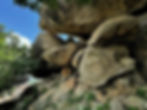Exploring Olumo Rock, The Ancient Fortress of the Egba people of Abeokuta
- foluoyefeso
- Jun 14, 2023
- 4 min read
Updated: Nov 19, 2024

Among the many intriguing stories in Nigeria's history, the tale of Olumo Rock stands out quite a bit. This imposing stack of granite boulders rests in the center of Egba land (modern-day Abeokuta), and is a symbol of great significance among the daughters and sons of the Egba kingdom.
It started out being used as a strategic location which gave one military advantage in times of war. The rocky outcrop provided many hiding places, which the Egba warriors cleverly used to counter enemy attacks. The name 'Abe okuta' literally translates to 'under the rock', and it was under this natural fortress that the Egba civilization spread from. The name 'Olu mo' translates to 'God formed/made' and it is regarded as a divine liberator of the children of Egbaland.

The Egba are a subgroup of the Yoruba tribe and were once a part of the Old Oyo Empire. They inhabited an area between Remo country and present-day Oyo town before their homestead was disturbed by the Owu war. The aftermath of that war had left much of Yorubaland in disarray but the Egba people were in a particularly chaotic situation, despite not being involved in what caused it. They were caught in the middle, accused from both sides of not coming to their aid in battle/secretly helping the other side, and these accusations would devolve into violence and destruction of Egba towns.
There would be total confusion in the land between 1825 and 1827 and the Egba people were dispersed and in disagreement with one another. A man called Lishabi Agbongbo Akala took it upon himself to unify the people against the oppression of the Oyo army and through transit camps around Ibadan and Odo-Ona, they finally made their way to Abeokuta under the leadership of Sodeke of Iporo following Lishabi's death around 1830
From here on, the main body of the Egba settlers settled at Olumo and began to form townships. Chief Sodeke would consult the Ifa Oracle, and then be assured of prosperity and protection as long as they sacrifice a cow to Olumo every year (till this day). For the first time in a while, the Egba people finally had a safe place to call theirs, and here, the different groups converged and built the town of Abeokuta around Olumo.
Olumo Rock is undoubtedly one of Nigeria's most famous attractions and it's not difficult to understand why. Apart from its cultural significance, the fortress has a mighty appearance and it serves as an imposing symbol of strength and unity that can be seen for many kilometers around. Visitors pay ₦1,000 for tickets and with that, you gain access to the complex which features Olumo, an art gallery and a souvenir shop. You are paired with a tour guide to accompany you on your climb and it's about 120 steps to the top, so it's not a very tedious hike.

The first area is the 'Lishabi garden', a grove shrouded by ancient trees and named in honor of the great Egba warrior. The garden houses a shrine which is the location for the special ceremonies, and only the Chief Priest and the Alake of Egbaland are allowed to enter. The ancient garden is home to trees like the pansheke tree, dongoyaro (neem) tree and the baobab tree, and the result is a serene environment to catch your breath.

The next part of the tour is the area of the mountain that was used for housing, and here you get the real sense of the words 'Abe Okuta'. This part of the mountain is sectioned into rooms and you notice traces of early human activity. The most fascinating aspects were the holes which they used to grind food in, the grave of the early caretaker of Olumo (Chief Sanni), and the pillars used to add extra support to the area.
Till today, the mountain is still inhabited by women who serve as caretakers and spiritual leaders of Olumo and we would come across them next. It is customary to give them some monetary tips in exchange for words of encouragement and blessings before moving on to the next part of the tour. They pray for you in Yoruba, wish you good will and divine guidance, and their words left me with a sense of calmness and ease.

The final part of the tour was the peak of Olumo rock, roughly 137 meters above sea level. From here you're treated to a beautiful wrap-around view of Abeokuta. The air feels crisp and fresh and you're filled with a sense of accomplishment from conquering the climb. You are also able to see some of the other places of interest that Abeokuta has to offer, such as the first Church in Nigeria (Saint Peter's Cathedral), the beautiful Kobiti Central Mosque, the Ogun river, MKO Abiola's family house and several others.

After having soaked up the wonders of Olumo's peak, I descended the rock with a deeper understanding of Abeokuta and it's people. I was filled with gratitude because I was able to experience yet another wonder of nature, especially one that was directly linked with the salvation of the Egba people. What I found most interesting is how over the centuries, the core role of Olumo in Egba society has remained unchanged. Upon its discovery, it was a hideout from the Ibadan army, then a settlement with great spiritual significance and today a popular tourist attraction but at it's center, Olumo has always been a provider and a unifier.